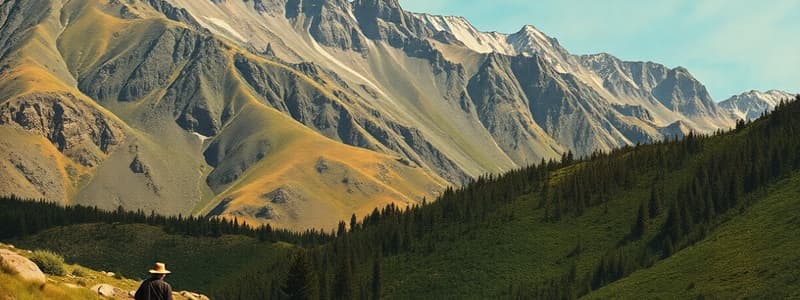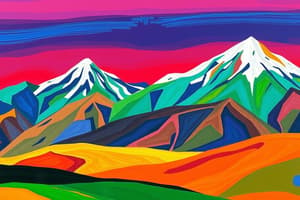Podcast
Questions and Answers
What geographic feature runs the length of South America?
What geographic feature runs the length of South America?
- The Rockies
- The Amazon River
- The Andes (correct)
- The Pampas
Which of the following regions contains the highest diversity of plant and animal species?
Which of the following regions contains the highest diversity of plant and animal species?
- The Andes (correct)
- The Rockies
- The Pampas
- The Amazon Rainforest
What is a primary agricultural benefit of the Pampas region?
What is a primary agricultural benefit of the Pampas region?
- Cattle raising and grain production (correct)
- Tropical fruit farming
- Mineral extraction
- High-altitude mining
How did indigenous civilizations adapt to the high elevations of the Andes?
How did indigenous civilizations adapt to the high elevations of the Andes?
Which type of climate is NOT typically found in the Andes?
Which type of climate is NOT typically found in the Andes?
What does the word 'Pampas' mean in the Quechua language?
What does the word 'Pampas' mean in the Quechua language?
Which region is primarily home to the Inca Civilization?
Which region is primarily home to the Inca Civilization?
What was the main interest of the Spanish conquistadors in the Andean region once occupied by the Incas?
What was the main interest of the Spanish conquistadors in the Andean region once occupied by the Incas?
What system did the Inca develop for record-keeping?
What system did the Inca develop for record-keeping?
Which climate types are included within the Pampas region?
Which climate types are included within the Pampas region?
What significant event in 1532 contributed to the downfall of the Inca Empire?
What significant event in 1532 contributed to the downfall of the Inca Empire?
Which city served as the administrative center for the Inca Empire?
Which city served as the administrative center for the Inca Empire?
What was the term used for Spanish people born overseas in South America who did not mix with Indigenous peoples?
What was the term used for Spanish people born overseas in South America who did not mix with Indigenous peoples?
Approximately how wide is the Pampas region?
Approximately how wide is the Pampas region?
Which of the following is NOT a recognized ecoregion of the Pampas?
Which of the following is NOT a recognized ecoregion of the Pampas?
Flashcards
Andes Mountains
Andes Mountains
A long mountain range in South America, spanning many climate zones.
Pampas
Pampas
A vast South American grassland ideal for farming and cattle.
Andean Civilizations
Andean Civilizations
Ancient societies that flourished in the Andes, like the Inca.
Tierra Fría
Tierra Fría
Signup and view all the flashcards
Pampas Climate
Pampas Climate
Signup and view all the flashcards
Quechua language
Quechua language
Signup and view all the flashcards
Inca Empire
Inca Empire
Signup and view all the flashcards
Criollos
Criollos
Signup and view all the flashcards
Inca achievements
Inca achievements
Signup and view all the flashcards
Inca Empire's downfall
Inca Empire's downfall
Signup and view all the flashcards
Quechua language origin
Quechua language origin
Signup and view all the flashcards
Pampas' economic activity
Pampas' economic activity
Signup and view all the flashcards
Pampas and Andes population differences
Pampas and Andes population differences
Signup and view all the flashcards
Study Notes
Andes Mountains
- Located along the length of South America
- One of the world's highest and longest mountain ranges
- Peaks reach over 22,000 feet
- Span various climate zones (equatorial, tropical, subtropical, temperate, boreal)
- Diverse biomes: rainforests, cloud forests, deserts, high-elevation grasslands, and salt flats
- Highest biodiversity of plants and animals globally
- Traditional human settlements concentrated in highland valleys and plateaus (tierra fría, tierra templada). páramos, puna, altiplano
- Moderate temperatures compared to lowlands, but low oxygen at high altitudes
- Cradle of human civilization with early domestication of maize, potatoes, coca, llamas, and alpacas
- Coca leaf helps with altitude sickness
- Hosted numerous civilizations (Muisca, Chavín, Inca, Mapuche)
- Indigenous peoples still present, often in majority, speaking various languages and combining traditional beliefs with Roman Catholicism
Pampas
- Vast grassland region in southeastern South America
- Located north and south of the Parana River
- Rolling, low-elevation grasslands
- Mild climate, rich soils, suitable for cattle ranching, grain production, and vineyards
- Origin of the word "Pampas" from Quechua meaning "plains" or "flat surface"
- Home to native animals (wolves, deer) and migratory birds
- Fewer large civilizations before European arrival. Primarily hunter-gatherer societies existed
- Covers part of Argentina, all of Uruguay, and Rio Grande do Sul, Brazil
- Stretches over 1,000 miles north-south, and 400 miles wide
- Contains major cities like Buenos Aires, Cordoba, Montevideo, and Porto Alegre
Inca Empire
- Powerful civilization centered in parts of the Andes(Ecuador, Peru, Bolivia
- Advanced empire organized via taxation and labor systems
- Extensive road network (flagstone-paved roads)
- lacked writing, instead used a complex record-keeping system, the quipu
- existed from the late 1400s CE and stretched 2,000 miles from north to south (including parts of what are today Colombia, Ecuador, Bolivia, Chile, and Argentina)
- Collapsed following the arrival of Spanish conquistador Francisco Pizarro
- Decimated by disease brought by the Spanish
- Inca wealth and resources (metal) exploited by Spaniards
Criollos and Indigenous Populations
- Criollos: Spanish-born people in the Americas who became overlords after the Inca empire fell
- Exploitation of Indigenous populations through forced labor and tribute systems
- Indigenous languages and customs were suppressed
- In Bolivia, the white criollo minority held power despite Indigenous majority. Indigenous people faced significant poverty and discrimination until Evo Morales's presidency
- Economic wealth of the Andes region shifted to resources like silver (especially in Potosi)
- The pampas economy developed around cattle ranching. Gaucho culture emerged
- Gauchos: cowboy heritage of mixed Indigenous, European, and African descent
Studying That Suits You
Use AI to generate personalized quizzes and flashcards to suit your learning preferences.
Description
Explore the incredible Andes Mountains, one of the world's highest and longest mountain ranges. This quiz covers diverse biomes, human settlements, and the indigenous cultures that thrive in this unique ecosystem. Additionally, learn about the Pampas region and its significance.




